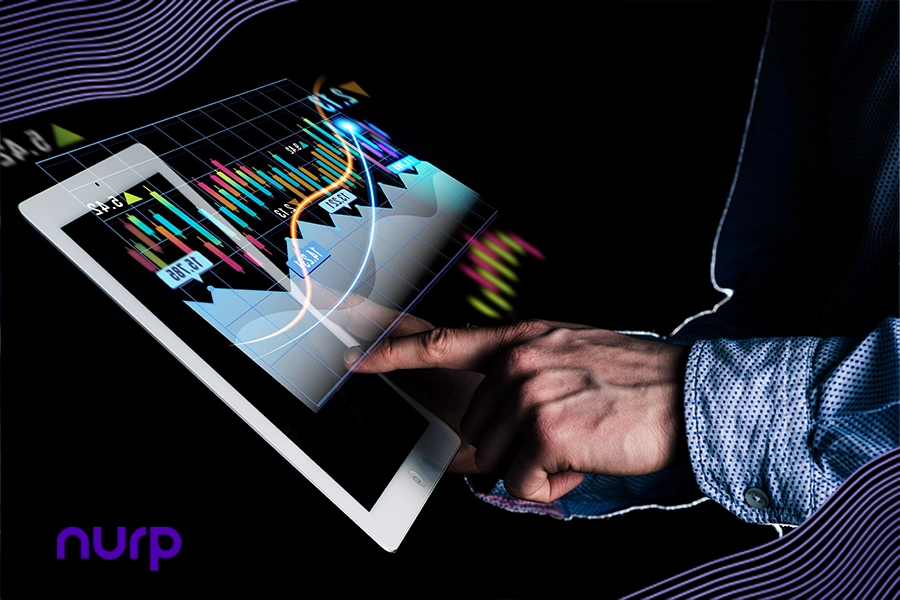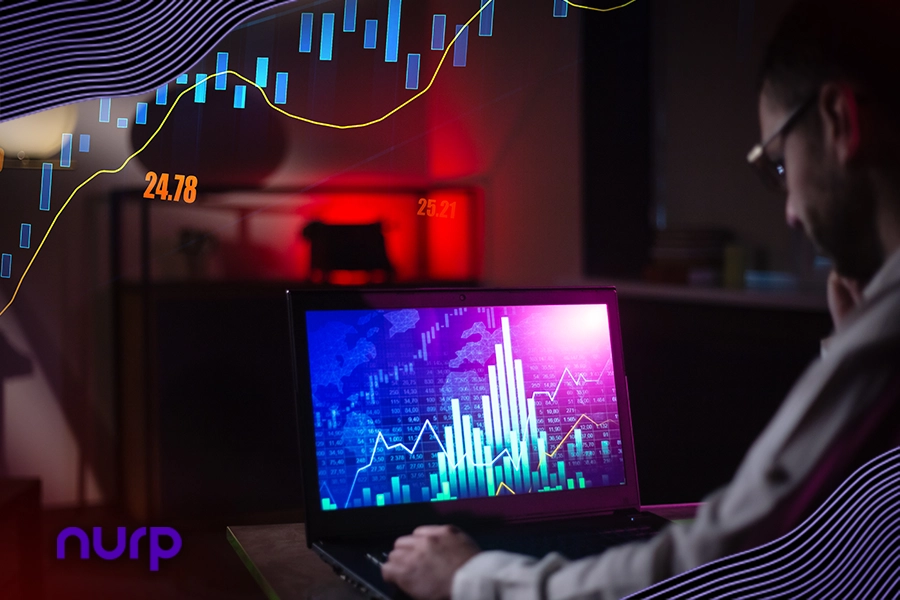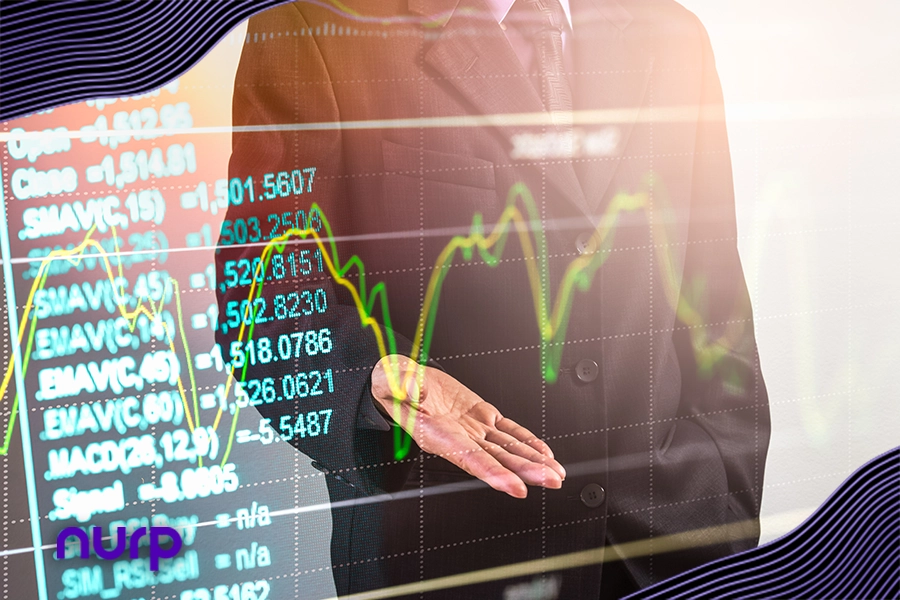Key Takeaways
Algorithmic trading offers precision and efficiency by removing emotional biases.
Backtesting allows traders to analyze strategy performance before risking real capital.
Leveraging technology can help beginners navigate forex markets with confidence and consistency.
Introduction
Embarking on the journey of forex trading can feel like stepping into a whirlwind world of both possibilities and uncertainties. For beginner traders, the complexities of the financial markets can be quite daunting. There are different possible strategies to adopt for those venturing into forex trading for the first time, one of which is algorithmic trading.
Algorithmic trading, often referred to as algo trading, harnesses the power of technology to execute trades automatically based on predefined criteria. Instead of relying on human intuition and emotion, algorithms analyze market data and execute trades with precision and efficiency.
One of the reasons given for the rise in the adoption of algorithmic trading is it reduces emotional biases and enhances decision-making. By removing the human element from trading, algorithms can execute trades at speeds beyond human ability, which increases the chances of taking advantage of opportunities in fast-moving markets. In addition, with algorithmic trading, traders can backtest their strategies using historical data, which can provide valuable insights into potential performance before risking real capital.
For beginner forex traders, algorithmic trading can be a very useful way to navigate market complexities with more confidence and consistency. By leveraging technology, new traders can potentially overcome emotional decision-making, lack of discipline, and other common pitfalls associated with manual trading.
This comprehensive guide goes on a detailed exploration of algorithmic trading, beginning from understanding the fundamentals to developing and optimizing trading strategies. It is important to highlight that no forex trading strategy guarantees profits or removes the risk of losses. Forex trading is inherently risky, and traders should never trade with money they cannot afford to lose. This guide is written for informational purposes and should not be taken as financial advice.
Read More: The Silent Giants of Wall Street: How Algorithmic Trading Is Quietly Building Fortunes
Understanding Algorithmic Trading
Algorithmic trading, also known as algo trading, has transformed the way traders operate in financial markets. This section explores the fundamental aspects of algorithmic trading, what it is, the execution process, its advantages, and how it compares to manual trading.
Definition and Explanation of Algorithmic Trading
Algorithmic trading refers to the use of computer programs, known as algorithms, to execute trading orders automatically. Trading algorithms are designed to follow predefined criteria, making trading decisions based on factors such as price movements, technical indicators, and market trends. Algorithmic trading aims to capitalize on market opportunities with speed and precision, leveraging technology and advanced data analysis techniques
How Algorithms Execute Trades
Algorithms function as sets of instructions that dictate when to buy or sell specific assets in the market. They continuously analyze vast amounts of real-time data to identify trading opportunities and execute trades accordingly. Unlike manual traders who must monitor the market and manually enter orders, algorithms can react to market conditions instantaneously, with the swift execution of trades at optimal moments.
Advantages of Algorithmic Trading
Algorithmic trading offers several advantages over manual trading. Speed: Algo trading excels in speed, executing trades within milliseconds, which is crucial in fast-moving markets. Efficiency: Algorithmic trading enhances efficiency by processing large volumes of data and executing trades across multiple markets simultaneously. This efficiency leads to lower transaction costs and improved profitability over time. Zero emotions: By removing the emotional element from trading decisions, algorithmic trading ensures a disciplined approach based solely on predefined criteria.
Comparison with Manual Trading
Compared to manual trading, algorithmic trading provides distinct advantages. Manual trading relies on human decision-making, prone to biases and emotions such as fear and greed. In contrast, algorithmic trading eliminates emotional influences, leading to more rational and disciplined trading decisions. In addition, algorithms can execute trades with precision, streamline risk management processes, and operate 24/7, which offers a competitive edge over manual traders.
Conclusion
Algorithmic trading has revolutionized the trading landscape by leveraging technology to execute trades with speed, efficiency, and precision. By following predefined criteria and analyzing real-time market data, algorithms can empower traders to capitalize on market opportunities. For beginner traders, embracing algorithmic trading can be a pathway to increasing their chances of success by mitigating emotional biases, enhancing trading efficiency, and maximizing profitability.
Benefits of Algorithmic Trading for Beginner Forex Traders
Algorithmic trading presents so many advantages for beginner forex traders, with a myriad of benefits that can enrich their trading experience. This section takes a detailed exploratory look at the advantages that algorithmic trading can potentially offer novice traders, highlighting its efficiency, objectivity, consistency, and risk management capabilities.
Efficiency and Speed: A Streamlined Trading Processes
Algorithmic trading is known for its efficiency and speed, transforming how trades are executed in the forex market. Unlike manual trading, where traders must analyze market data and enter orders manually, algorithms process vast amounts of information instantaneously and execute trades within milliseconds. This gives traders a significantly higher chance of capitalizing on market opportunities promptly, and without delay, giving them a competitive edge in the fast-paced markets. Moreover, a trading algorithm can operate 24/7, the same as the forex markets, which means traders can take advantage of trading opportunities across different time zones and ensure continuous market coverage. By leveraging algo trading, traders can mitigate the risk of missing out on profitable trades due to human limitations such as fatigue.
Objectivity: Eliminating Emotional Biases
One of the primary advantages of algorithmic trading is its ability to eliminate emotional biases from trading decisions. Emotions such as fear, greed, and hesitation often cloud the judgment of manual traders, leading to irrational decisions and inconsistent performance. However, by following predefined criteria and executing trades based on objective parameters, algorithms make for a disciplined and rational approach to trading, free from emotional influences. This objectivity can help beginner traders maintain consistency in their trading decisions and avoid common pitfalls associated with emotional trading. By removing emotional biases, algorithmic trading offers a more systematic and reliable approach to trading for beginners in the forex market.
Consistency: Executing Trading Strategies with Precision
Algorithmic trading provides beginner traders with a mechanism to implement and execute trading strategies consistently. When a strategy is programmed into an algorithm, it adheres strictly to predefined rules and parameters, eliminating any possibility of deviation. This objectivity helps beginner traders maintain consistency in their trading decisions, empowers them to avoid the common pitfalls associated with emotional trading, and improves their chances of achieving more favorable trading outcomes. With algorithms at their disposal, novice traders can depend on the precise execution of their strategies, even amidst volatile market environments. This reliability instills in them a sense of peace of mind and confidence in their trading approach, allowing them to navigate the forex market with greater assurance and efficacy.
Risk Management: Diversification and Control
Diversification and risk management are essential aspects of successful trading, and algorithmic trading offers traders opportunities for both. Beginner traders can deploy multiple algorithms across different currency pairs or trading strategies, spreading their risk and reducing reliance on a single trading approach. In addition, trading algorithms can incorporate risk management parameters such as stop-loss orders and position sizing rules, helping beginner traders manage their risk exposure more effectively. Diversifying their trading activities and implementing robust risk management strategies increases the chances that novice traders can safeguard their capital.
Access to Advanced Analytical Tools: Informed Decision-Making
Algorithmic trading provides beginner traders with access to advanced analytical tools and techniques that can aid in decision-making and strategy development. Algorithms can analyze vast amounts of historical and real-time market data, identify patterns, and generate insights that may not be apparent to manual traders. By leveraging these analytical capabilities, beginner traders can make more informed decisions and refine their trading strategies effectively. Whether it’s identifying market trends, detecting trade opportunities, or optimizing trading parameters, algorithms empower novice traders to stay ahead of the curve and make smarter trading choices.
Backtesting and Optimization: Refining Trading Strategies
Another benefit of algorithmic trading is the ability to backtest and optimize trading strategies before deployment. Beginner traders can simulate their strategies using historical market data to evaluate their performance under various market conditions. By analyzing backtest results, traders can identify strengths and weaknesses in their strategies and make necessary adjustments to optimize performance before trading live. This iterative process of backtesting and optimization allows novice traders to refine their approaches and improve their trading outcomes
In conclusion, algorithmic trading offers many benefits for beginner forex traders. This ranges from increased efficiency and speed to the elimination of emotional biases and consistent execution of trading strategies. Embracing algorithmic trading can be a way for novice traders to access advanced analytical tools, diversify their trading activities, and improve how they manage trading risks. The ability to backtest and optimize trading strategies is also an advantage, as it empowers beginners to refine their approaches. This can increase their chances of success, by improving their trading outcomes over time.
Read More: Investor Alert: SEC’s Guidelines for Algorithmic Trading
Challenges of Algorithmic Trading
Algorithmic trading offers numerous benefits, but it’s not without its challenges. In this section, we’ll explore some of the key challenges that traders may encounter when engaging in algorithmic trading.
Market Volatility and Uncertainty
One of the significant challenges in algorithmic trading is dealing with market volatility and uncertainty. Financial markets are influenced by various factors, including economic data releases, geopolitical events, and unexpected news developments. These factors can lead to sudden price fluctuations and erratic market behavior, making it challenging for algorithms to adapt quickly. Traders need to design algorithms that can withstand volatile market conditions and adjust their strategies accordingly to minimize losses and capitalize on opportunities.
Over-Optimization and Curve Fitting
Another challenge in algorithmic trading is the risk of over-optimization and curve fitting. Traders may fine-tune their algorithms to perform exceptionally well on historical data, but such optimization can lead to poor performance in live trading conditions. Over-optimized algorithms are tailored too closely to past market conditions, making them less adaptable to future changes. Traders must strike a balance between optimizing their algorithms for historical data and ensuring robustness and adaptability in real-world trading environments.
Technical Complexity
Algorithmic trading involves a high degree of technical complexity, which can pose a challenge for beginner traders. Developing and implementing trading algorithms require proficiency in programming languages, quantitative analysis techniques, and software development frameworks. Traders need to have a solid understanding of concepts such as data structures, algorithms, and statistical modeling to design effective trading strategies. Moreover, staying abreast of advancements in technology and market trends requires continuous learning and adaptation.
Infrastructure and Connectivity Issues
Successful algorithmic trading relies heavily on robust infrastructure and reliable connectivity to trading venues. Traders need access to high-speed internet connections, powerful computing hardware, and low-latency trading platforms to execute trades swiftly and efficiently. Any disruptions or delays in connectivity can result in missed opportunities or execution errors, impacting trading performance. Moreover, traders must ensure redundancy and failover mechanisms to mitigate the risk of system failures or downtime.
Regulatory and Compliance Concerns
Algorithmic trading is subject to regulatory oversight and compliance requirements, which can vary across different jurisdictions. Traders need to adhere to regulations governing electronic trading, algorithmic strategies, and market manipulation to avoid legal and financial repercussions. Compliance with regulatory standards adds an additional layer of complexity to algorithmic trading, requiring traders to implement robust risk management controls and monitoring systems.
Psychological Challenges
Despite being automated, algorithmic trading still involves human decision-making and oversight. Traders may experience psychological challenges such as overconfidence, fear of missing out (FOMO), and emotional attachment to trading strategies. Overcoming these psychological biases requires discipline, self-awareness, and adherence to predefined trading rules. Moreover, managing the psychological aspects of trading is essential for maintaining consistency and rationality in decision-making.
In summary, algorithmic trading presents several challenges that traders must navigate to succeed in the financial markets. By addressing these challenges effectively and continuously refining their strategies and processes, traders can enhance their algorithmic trading performance and improve their chances of achieving their trading goals.
Getting Started With Algorithmic Trading: Essential Tools and Resources
Embarking on the journey of algorithmic trading as a beginner requires the right tools and resources to navigate the complexities of the financial markets effectively. This section explores some of the essential tools and resources that traders need to start off their algorithmic trading journey. With the right tools and access to relevant resources, beginners are more likely to succeed in their algorithmic trading adventure. Whilst this section mentions different tools and resources, it is not an endorsement of any of them. Traders should carry out their own research and evaluate each tool before adoption.
Choosing a Trading Platform
Selecting the right trading platform is crucial for executing algorithmic trading strategies effectively. Among the plethora of options available to choose from, renowned platforms such as MetaTrader 4 (MT4) and MetaTrader 5 (MT5) stand out as favored among traders worldwide. These platforms offer features such as intuitive interfaces, comprehensive backtesting functionalities, and native support for algorithmic trading through their proprietary programming languages, MQL4 and MQL5. In addition to that, alternatives like NinjaTrader, TradeStation, and Interactive Brokers offer sophisticated features and seamless connectivity across multiple markets, presenting algorithmic traders with flexibility and scalability for their trading endeavors.
Programming Languages
Programming languages are essential components of algorithmic trading, providing traders with the means to code and implement sophisticated trading algorithms. Among the plethora of options available, Python and R emerge as the leading choices for algorithmic traders, owing to their simplicity, versatility, and rich libraries tailored for data analysis and machine learning tasks.
Python, with its vast array of libraries such as pandas, NumPy, and TensorFlow, empowers traders with robust tools for data manipulation, statistical analysis, and algorithm development, making it particularly appealing to beginners looking to delve into algorithmic trading. On the other hand, R, renowned for its prowess in statistical computing, offers traders a formidable toolkit for quantitative analysis and data visualization, further augmenting its appeal in the algorithmic trading sphere.
As traders embark on their algorithmic trading journey, the choice between Python and R hinges on factors such as personal preference, familiarity with the language, and specific trading requirements, underscoring the importance of selecting the most suitable programming language to meet their individual needs and objectives.
Algorithmic Trading Libraries and Frameworks
Algorithmic trading libraries and frameworks provide essential tools and resources for aspiring traders seeking to delve into algorithmic trading. These platforms, including MetaTrader, QuantConnect, and TradingView, offer an extensive array of tools and resources designed to facilitate the development and deployment of trading algorithms.
MetaTrader is considered to have a robust built-in development environment, which grants users access to historical data, real-time market quotes, and a vibrant community of traders and developers. Meanwhile, QuantConnect provides a versatile cloud-based platform equipped with support for multiple programming languages, expansive data libraries, and sophisticated backtesting capabilities.
Educational Resources
Educational resources play a vital role in equipping traders with the knowledge and skills needed to succeed in algorithmic trading, particularly for beginners venturing into this dynamic field. A plethora of resources, including books, online courses, and tutorials, are available to cater to diverse learning needs and preferences. These invaluable materials cover an extensive range of topics, encompassing algorithmic trading fundamentals, programming fundamentals, quantitative analysis methodologies, and risk management techniques.
By utilizing these indispensable tools and resources, novice traders can potentially establish a robust groundwork in algorithmic trading, laying the groundwork for their journey with assurance and poise. Through unwavering commitment, ongoing education, and practical application, individuals aspiring to delve into algorithmic trading can unlock the vast potential of automated trading systems and realize their financial objectives within the ever-evolving landscape of financial markets.
Developing a Trading Strategy
A robust and solid trading strategy is crucial for increasing the chances of success in algorithmic trading. It serves as the backbone, guiding traders in making informed decisions and managing risks. This section delves deeper into the critical components of formulating a trading strategy. This includes setting clear trading goals and incorporating technical and fundamental analysis, as well as integrating various approaches to maximize outcomes and dynamically adapt to market conditions. Let’s explore these aspects in detail to equip beginner traders with the necessary knowledge and tools to excel in algorithmic trading.
Importance of a Well-Defined Strategy
A well-defined trading strategy is comparable to a guiding light that illuminates the path through the complexities of the financial markets. For novice traders, laying the groundwork begins with a detailed and careful examination of their trading goals. Whether the aim is to safeguard capital, generate income, or amass wealth, clarity in objectives is vital Equally significant is how traders comprehend risk tolerance, which is the cornerstone upon which trading decisions are built. It outlines the threshold of acceptable risk, shaping the trajectory of one’s trading journey. A robust trading strategy charts a course toward a trader’s financial goals, it can also be a useful tool to instill discipline and resilience amidst market volatility.
Technical Analysis
Technical analysis is a cornerstone of algorithmic trading, providing traders with valuable insights gleaned from historical market data. By delving into the nitty-gritty of historical price movements, traders can identify trends and patterns that guide their trading decisions. Within the realm of technical analysis, there are a plethora of indicators that come into play. From the moving averages to the relative strength index (RSI) and oscillators, these tools offer nuanced perspectives on market momentum, volatility, and trend direction. In addition, chart patterns play a vital role in depicting the ebb and flow of market dynamics. These include patterns such as the head and shoulders, the double tops, or the triangles, with each pattern unveils a narrative of market sentiment.
Fundamental Analysis
Fundamental analysis involves evaluating economic indicators, news events, and geopolitical shifts to unravel the intrinsic value of an asset. Within this expansive realm, traders cast their nets wide, incorporating a diverse array of factors into their trading strategies. These factors include interest rates, inflation, GDP growth, and geopolitical tensions, with each of these variables influencing how the markets move. Economic calendars and news feeds emerge as indispensable allies, offering real-time updates on pertinent events. With this wealth of information, traders can potentially anticipate market movements with foresight, recalibrating their positions adeptly in response to evolving market conditions. Fundamental analysis provides insight and illuminates the path to a higher chance of trading success even in the face of the ever-changing financial markets.
Combining Approaches
Integrating technical and fundamental analysis is a pivotal step in algorithmic trading. By blending these methodologies, traders gain a holistic view of market dynamics, enhancing their strategies. For instance, a trader might use technical indicators to spot entry and exit points, while relying on fundamental analysis to validate decisions. This synergy allows traders to navigate the market with confidence and precision, capitalizing on opportunities effectively. Through this approach, traders unlock a wealth of insights, empowering them to make informed decisions and pursue profitability.
In summary, developing a trading strategy is a critical step in algorithmic trading, enabling traders to define their objectives, analyze market conditions, and execute trades with confidence. By incorporating technical and fundamental analysis and adapting to changing market dynamics, beginner traders can enhance their chances of success in the dynamic world of algorithmic trading.
Backtesting and Optimization
Backtesting and optimization are essential components of algorithmic trading, allowing traders to evaluate the performance of their trading strategies and fine-tune them for optimal results. Backtesting involves testing trading strategies using historical market data to assess how they would have performed in the past. Traders use backtesting to simulate trades and measure key performance metrics such as profitability, risk-adjusted returns, and drawdowns. By analyzing the results of backtesting, traders can gain insights into the effectiveness of their strategies and identify areas for improvement.
Optimizing Strategies
Once a trading strategy has been backtested, traders can optimize it by refining parameters to maximize profitability and minimize risk. Optimization involves adjusting variables such as entry and exit criteria, position sizing, and risk management rules to improve the strategy’s performance. Traders may use optimization techniques such as parameter sweeps, genetic algorithms, or machine learning algorithms to identify the optimal set of parameters that produce the best results.
Pitfalls to Avoid
While backtesting and optimization can be powerful tools for improving trading strategies, they also come with pitfalls that traders should be aware of. One common mistake is overfitting, where traders fine-tune their strategies to perform well on historical data but fail to generalize to unseen market conditions. To avoid overfitting, traders should use out-of-sample testing and robustness checks to validate their strategies across different market environments. Another pitfall is data snooping bias, where traders cherry-pick data or variables to support their hypotheses. Traders should use rigorous statistical methods and maintain a skeptical attitude when interpreting backtesting results to avoid falling into this trap.
In conclusion, backtesting and optimization are indispensable tools for algorithmic traders seeking to develop and refine their trading strategies. By rigorously testing their strategies on historical data and avoiding common pitfalls, traders can gain confidence in their approaches and increase their chances of success in the dynamic world of algorithmic trading.
Risk Management and Capital Preservation
Risk management is a critical aspect of algorithmic trading, ensuring traders can navigate the dynamic and often unpredictable financial markets while safeguarding their capital. Risk management serves as a shield for traders, protecting their capital from adverse market movements and minimizing the impact of losses. By implementing sound risk management practices, traders can enhance the longevity of their trading endeavors and increase their chances of long-term success.
Position Sizing
Position sizing, a pivotal element of risk management, plays a crucial role in deciding the portion of capital allocated to individual trades. To execute this effectively, traders must take into account several factors including their risk tolerance, account size, and overarching trading goals. Through careful allocation of capital, traders can adeptly mitigate the possibility of substantial drawdowns, thereby safeguarding their trading capital for prolonged periods.
Setting Stop-Loss Orders
Stop-loss orders are indispensable instruments for risk management within algorithmic trading. These automated mechanisms empower traders to establish predetermined exit points for their trades, effectively curtailing potential losses. By strategically placing stop-loss orders at specific levels, traders can shield their capital and forestall impulsive decision-making amid instances of market turbulence. This proactive approach not only safeguards their investments but also instills a sense of discipline and rationality in their trading practices.
In summary, effective risk management is essential for algorithmic traders to navigate the challenges of the financial markets successfully. By implementing strategies such as position sizing and setting stop-loss orders, traders can mitigate risk, preserve their capital, and increase their chances of long-term profitability.
Going Live: Transitioning to Real Trading
Before diving into live trading, beginner traders should utilize demo accounts to practice their strategies in a risk-free environment. Demo accounts mimic real market conditions, allowing traders to familiarize themselves with the trading platform and test their algorithms without risking real money. This phase provides an opportunity to refine trading strategies, experiment with different approaches, and gain valuable experience.
Starting Small
When transitioning to live trading, it’s essential to start with small position sizes. This approach helps mitigate risk while allowing traders to gain confidence in their strategies. By starting small, traders can assess the effectiveness of their algorithms in real market conditions without exposing themselves to significant losses. As traders become more comfortable and confident in their abilities, they can gradually increase their position sizes and scale up their trading activities.
Monitoring and Adjusting
Once live trading begins, it’s crucial to monitor the performance of trading strategies closely. Traders should analyze trade outcomes, track key performance metrics, and identify areas for improvement. By continuously monitoring their trades, traders can gain insights into the effectiveness of their algorithms and identify opportunities for optimization. Based on live performance, traders can refine their strategies, adjust parameters, and implement changes to enhance their trading outcomes.
Embracing Continuous Learning
Transitioning to live trading marks the beginning of a journey of continuous learning and improvement. Beginner algorithmic traders should embrace this process and remain open to acquiring new knowledge and skills. Engaging with trading communities, attending webinars, and reading relevant literature can provide valuable insights and perspectives. By staying informed and adaptable, traders can navigate the challenges of live trading more effectively and increase their chances of long-term success.
The Role of Algorithmic Trading Companies
Algorithmic trading companies play a crucial role in providing the tools, technology, and support needed for traders to streamline their strategies and optimize their performance in the financial markets. These companies operate by offering comprehensive platforms and services tailored to the needs of traders, with a focus on innovation, reliability, and user experience.
Platform Development
Algorithmic trading companies invest heavily in developing and maintaining trading platforms that cater to traders of all experience levels. These platforms typically offer advanced charting tools, customizable indicators, and sophisticated order execution capabilities. Companies strive to continuously enhance their platforms with new features and functionalities to meet the evolving needs of traders in today’s fast-paced markets.
Technology Infrastructure
Behind the scenes, algorithmic trading companies maintain robust technology infrastructure to ensure the reliability and performance of their platforms. This includes high-speed servers, data feeds, and connectivity solutions that enable traders to execute trades quickly and efficiently. Companies also invest in data storage and security measures to protect sensitive information and ensure compliance with regulatory requirements.
Support and Education
In addition to providing cutting-edge technology, algorithmic trading companies offer comprehensive support and education resources to help traders succeed. This may include tutorials, webinars, and documentation to assist traders in understanding how to use the platform effectively. Companies also offer customer support services to address any technical issues or questions that traders may have, ensuring a seamless user experience.
Innovation and Research
To stay ahead in the competitive landscape of algorithmic trading, companies prioritize innovation and research to develop new trading strategies, algorithms, and tools. This involves collaborating with industry experts, data scientists, and academic researchers to explore emerging trends and technologies in quantitative finance. By pushing the boundaries of innovation, companies strive to empower traders with the latest advancements in algorithmic trading.
Accessibility and Affordability
Algorithmic trading companies aim to make their platforms accessible and affordable to traders of all backgrounds. This may involve offering flexible pricing plans, including commission-free trading options or low-cost subscription models. Companies also focus on user-friendly interfaces and intuitive design to ensure that traders can easily navigate the platform and execute trades without technical barriers.
Overall, algorithmic trading companies play a pivotal role in empowering traders to achieve their financial goals. By providing cutting-edge technology, comprehensive support, and innovative solutions, these companies enable traders to capitalize on market opportunities.
Conclusion
Algorithmic trading has transformed the financial markets, providing traders with remarkable chances to fine-tune their strategies and meet investment goals. Throughout this guide, we have delved into its core concepts, practical applications, and the hurdles it brings.
Above all, algorithmic trading enables swift and efficient trade execution, using automated algorithms to seize market opportunities in real-time. This technology-driven approach helps eliminate emotional biases, letting traders base decisions on solid criteria and preset parameters.
Moreover, algorithmic trading offers traders a plethora of tools, resources, and educational materials to boost their trading journey. From advanced platforms and programming languages to educational courses, traders have access to what they need to thrive.
Yet, it’s crucial to acknowledge the challenges algorithmic trading poses. Strategy development, backtesting complexities, market volatility risks, and technical failures are hurdles traders must navigate. There is also the fact that forex trading is inherently risky and neither algorithmic trading nor any other strategy can guarantee profits or eliminate the risk of losses. However, with strategic planning, risk management, and continuous learning, traders can overcome these obstacles and increase their chances of success.
Looking forward, algorithmic trading’s future looks promising, with technology, data analytics, and artificial intelligence driving innovation. As algorithms evolve, traders can anticipate greater precision and efficiency in their strategies. Moreover, the accessibility of algorithmic trading tools will expand, allowing traders from all backgrounds to participate.
The post The Power of Speed and Precision: An Algorithmic Trading Handbook For Beginners first appeared on Nurp.com.








